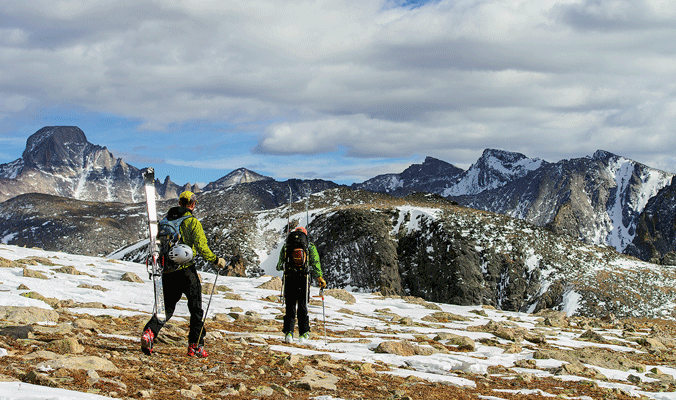This week, we are dedicating our platform to sharing stories of climate change within the landscapes and communities of backcountry skiing and riding, in recognition of the Columbia Journalism Review’s Covering Climate Now.
First up, a story about traversing and managing the warming winters in Colorado’s Rocky Mountain National Park, first published in the February, 2019 Skills Guide.

It’s 8:30 a.m. on a cold February morning, and we’ve been on the move for roughly two hours. I’ve sweated through my baselayer, and small crystals of ice are beginning to form on the cuffs of my sleeves. That’s not good.
Silence ensues as my partner, Kyle, and I huddle behind a large boulder in Colorado’s Rocky Mountain National Park (RMNP). For a moment everything is still. The cold drifts away as the clouds part and cover us in warm morning light. Just as the feeling reenters my fingers, a loud roar echoes across the valley. We brace for the incoming wind, attempting to force our bodies lower into the shallow snow against the rock. No success. Our warm and golden morning turns cold and white.
This is a typical scene in RMNP, where weather systems constantly punish skiers attempting to go deep. The mix of steep valley walls and high alpine peaks makes for a scene similar to what’s found in Patagonia.
What isn’t typical of Rocky Mountain National Park is the declining snowpack the region has been experiencing over the past few decades. Historically, Colorado has, on average, one of the deepest snowpacks across the lower 48 states. Its annual snowfall is crucial for the Colorado River’s watershed, which feeds into seven basin states including Arizona, California, Colorado, Nevada, New Mexico, Utah and Wyoming.
But over the past 20 years, the median snowpack for February has declined 15 percent, according to the U.S. Department of Agriculture. For Colorado, this percentage drop directly influences the state’s ski tourism, as well as access to fresh water from the Colorado River.
After I finish the remaining water in one of my bottles, Kyle and I continue into the white void. I start breaking trail, choosing to head toward a patch of trees that will grant us access to a ridge as well as some cover from the wind. I look down to shield my eyes from a hurricane of razor-sharp fragments ricocheting off of my face.
With my face turned down, I notice something odd about the skintrack I’ve been creating; it’s full of ice and dirt, rather than snow. We’ve traveled for half an hour since I began breaking trail, and I haven’t even felt a need to stop, let alone slow down. Without knee-deep snow, my body freely floats across the landscape.
I’ve reached a patch of trees, and the gusts of wind have finally died down. Kyle and I decide to stick to the ridge despite the added exposure to the elements. I look across the basin and glimpse the adjacent slope through blowing snow. Despite today’s gusts and cold temperatures, the mountainside looks as if it’s still within the clutches of fall, not mid-winter.
The shortcomings of this winter have me wondering if it’s a fluke year or if storms are just arriving a little later due to uncontrollable atmospheric patterns over the Pacific. Or are the late, diminishing winters part of a larger trend? Sure, I’ve had a couple great ski days during the past few years. It seems, however, as if I hear an exceptionally large number of my friends’ stories littered with suggestions of “we should have moved to Canada.”
Most answers to the question of “where’s the snow,” point toward human-caused climate change. According to a report from the Intermountain West Climate Summary, Colorado has experienced an increase in temperatures of two degrees Fahrenheit from 1977 to 2006. To experience this lack of snow in the region that forms the Colorado River’s headwaters should be an uncommon feeling, yet it’s beginning to be more and more familiar every year.
Soon we reach the top of the ridge and are ready to drop into our line. I lean down to clip into my binding. My boots are locked, skins are packed and beacon is on. I make the first turn, easing into the familiar motion of a controlled arc through the fresh storm snow. All of a sudden I’m met with a thud of rocks and dirt ripping into the bases of my skis. It’s another increasingly familiar feeling.










Interesting, but this year was a larger-than-average snowfall in Colorado’s Rocky Mountains, resulting in larger-than-average snowpack. I wish this article had addressed this rather than act like this year had the same drought conditions as last year. Although instances of drought are likely to persist in the Rockies, acting like every year is a drought year just perpetuates confusion regarding the impacts of climate change, and the changes that we should expect. One of the dangers we face with climate change effects is that they are inherently difficult to predict. We should not downplay that; we should emphasize that. Otherwise, it becomes too easy to say, “well, I saw plenty of snow in the Rockies this year, so I think we’re safe from climate change”.
I tend to agree with Selena’s comments. There is considerable year to year variation in snowpack depth and long term trends are not readily discerned unless one looks at lots of data. Here is the snowpack depth measured on May 1 at Cameron Pass for a few recent years:
2012 21″
2013 42″
2014 82″
2015 43″
2016 63″
2017 51″
2018 54″
2019 60″
One can’t conclude very much from such limited data.
John
Thanks John, always nice to have your reasoned input.
So to reiterate, despite this misleading article, Winter 2018-2019 was a stellar snow year for Colorado rockies, skiing from October to July. Authors, why the deception?
Hoping this winter will be another great one!!